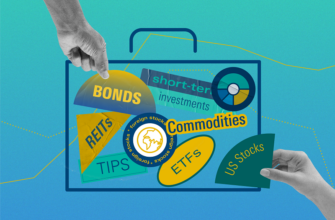The ability to handle money is an important skill. Financially literate people know how to increase income without harsh savings and loans. They achieve goals that people with similar incomes “don’t have the means” to achieve.
- The first step to economic literacy is a personal financial plan
- Step 1. Translating dreams into goals
- Your financial goals are likely to be multiple. For each you need to evaluate:
- Step 2. Calculate revenue
- Total income consists of three components:
- Step 3. Counting expenses
- Expenses are also divided into several categories:
- Once again about the goals
- Step 4. Protecting the financial plan
- How to protect yourself from risks
- So now you have:
- Step 5. Where to invest?
- Conservative tools
- Aggressive tools
- Step 6. Execute the financial plan
The first step to economic literacy is a personal financial plan
Step 1. Translating dreams into goals
A carefully formulated goal is half the battle. Instead of an abstract “I want more money” – a concrete one: “I want to receive 100000 dollars of passive income per month in 10 years.” This formulation is clear, incalculable, and you can choose financial instruments for it.
Your financial goals are likely to be multiple. For each you need to evaluate:
- Time – when you plan to achieve the goal.
This can be a specific date (buy a car in 2 years) or a long period (20 years to receive an increase to buy a second house by the sea).
- Money – determine what amount is needed.
If you plan to buy something specific, check the chart of price growth in the market and put this amount in the cost of the goal. If the goal is stretched over time (for example, the retirement period) – determine the target income per month.
Divide the formulated big goal into small ones: calculate how much you need to save each month
To achieve the goal, you may need to find an additional source of income, reduce costs, or revise the time frame for its implementation.
Remember that buying a car is the purchase of liabilities. Household appliances, a new iPhone, and the apartment you live in are also liabilities. They will not bring income, but on the contrary, will become cheaper and require maintenance costs. Think about it: maybe instead of liabilities, you should buy assets: securities, an apartment to rent, invest money in a bank deposit — so that they work and bring profit.
Step 2. Calculate revenue
Total income consists of three components:
- Income from labor – wages
How to increase it? Discuss with your superiors a promotion, change your permanent job or find an additional part-time job.
- Income from the state
Benefits and tax deductions.
How to increase it? Study the legislation. You may not be using the benefits you are entitled to. For example, if you were treated at a paid clinic in the current year, you can return up to 13% of its cost.
The Council.If you open an ICI (individual investment account), then in addition to the income from investments, you will be able to receive a tax deduction of certain amount deposited on the ICI during the year.
- Income from assets
This money is not the result of direct labor, but of competent investments of capital. This includes income from securities, deposits, real estate, businesses, etc.
How to increase it? Invest your money wisely. The more profitable assets, the greater the flow of money in addition to labor income. Of course, drawing up a portfolio, choosing a strategy, and analyzing the market will also require effort. You can minimize them by choosing a ready-made investment strategy.
There is an opinion that the only way to increase income is to find a job with a higher salary. As you can see, this is not only not the only, but also not the most attractive method.
Step 3. Counting expenses
Expenses are also divided into several categories:
- Current expenses
Food, rent, expenses for transport, treatment, etc. Everything that is necessary to maintain the usual standard of living.
How to reduce it? Having many goals, internal values, according to which we decide how to spend money. Therefore, it is very important to negotiate with yourself: set priorities and find a compromise. If you just go into austerity mode and start limiting yourself in everything, a breakdown is inevitable. It is important to see your needs behind unwanted spending and think about how else you can meet them.
- The cost of assets
We pay them to earn money. Bank account maintenance, broker services, business expenses, repair of a rented apartment and others. You can save money on some points: for example, many brokers have free registration and maintenance of a brokerage account.
How to reduce it? These expenses eventually bring money, so you should not completely abandon them. But there is an exception — if the cost of maintaining an asset constantly exceeds the income it brings, it is better to sell it. An example is a property that has been idle for a long time without a tenant, but requires constant expenses for repairs, utilities and taxes.
- Social spending
Everything we owe the state: taxes and fines.
How to reduce it? Study the legislation again: maybe you will find a more profitable tax scheme for yourself. For example, a patent allows some individual entrepreneurs to pay less taxes etc.
- Loan repayments
How to reduce it? Refinance the loan at a lower rate, use unprofitable assets to repay the debt, or extend the loan period. This will reduce your monthly payment, but the total overpayment will increase.
Once again about the goals
Calculate the actual difference between the” plus “and” minus ” budget. After that, compare it with the monthly cost of all financial goals: is there enough for everything? If not, the plan needs to be finalized.
Write down the priority goals: can I temporarily abandon those that are at the end of the list? You can always go back to them. For example, if revenue increases or when the first goal in the list is completed.
If all financial goals are vital, then it is worth considering credit instruments. But think carefully and count. When loan repayments amount to more than 30% of income, this is a very high credit burden, which is dangerous for the implementation of the financial plan..
In some cases, lending may be more profitable than self-accumulation. For example, you want to buy something particular in 2 years, the prices of which are growing very quickly — by 20% per year. If you are given a loan at 15% for 2 years — it will be cheaper to take a loan from a bank and buy a thing now than to save for it yourself for 2 years.
Step 4. Protecting the financial plan
Life is an unpredictable thing. Unexpected expenses, divorce, illness, economic crisis-all these unpleasant events put your well-being at risk. And along with it, the financial plan is also being shaken.
How to protect yourself from risks
Solve problems in advance. Think about what might happen and how these events will affect your financial goals, and how you can reduce their negative impact.
If you do not have a financial cushion, its formation should be included in the list of priority financial goals. You should accumulate at least three monthly incomes and invest them in conservative financial instruments. For example, to divide between a deposit in a bank with the possibility of partial withdrawal and investments in OFZ. Government bonds can have different maturities and interest payment periods (coupons).): you can choose the one that suits you depending on when you want to return the attachments.
It is worth considering buying insurance programs for different types of risk and include this in the costs.
If you have non-profitable assets (for example, a stagnant business), you can sell them, and use the proceeds in a reserve fund or for insurance costs.
So now you have:
- clarified all the goals: general and monthly;
- analyzed income and expenses and decided how to optimize them;
- took into account the costs of protecting against risks;
- ready to save money for the desired goals;
- It remains to decide which financial instruments to choose for this purpose.
Step 5. Where to invest?
It is important not to keep all your savings in an envelope/in a safe/under your pillow. There they will simply lie, not work — and gradually devalue due to inflation. There are more attractive ways.
Conservative tools
Investments in them are considered low-risk. They give almost 100% guarantee of the safety of your capital, plus a percentage of income. Conservative investments include bank deposits, insurance savings programs, pension capital accumulation products, government bonds, real estate, ETFs.
The disadvantage of conservative investment is low profitability.
Aggressive tools
If you want to get closer to achieving your goal, and the potential yield of conservative instruments is not enough for you, you can add aggressive ones to your portfolio. With such a strategy, the risks are higher, but the profitability, as a rule, is greater.
Such instruments include stocks, corporate bonds, investments in startups, currency trading, futures and options, mutual funds.

Step 6. Execute the financial plan
So, the financial plan is made, and all the goals are achievable. But the work continues: after calculating and refining the plan, it must be successfully completed.
- A personal financial plan is necessary for every person, regardless of their income.
- Financial goals should be reasonable, clearly defined, and achievable.
- Goals can be achieved earlier if you increase revenue and reduce costs.
- The financial plan must be protected by insurance or by creating a reserve fund.
- Savings should be invested in financial instruments in accordance with your investment strategy.








